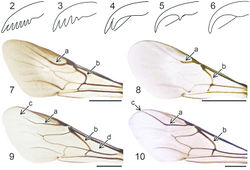Holopyga generosa\according to Paukkunen et al 2015
| Notice: | This page is derived from the original publication listed below, whose author(s) should always be credited. Further contributors may edit and improve the content of this page and, consequently, need to be credited as well (see page history). Any assessment of factual correctness requires a careful review of the original article as well as of subsequent contributions.
If you are uncertain whether your planned contribution is correct or not, we suggest that you use the associated discussion page instead of editing the page directly. This page should be cited as follows (rationale):
Citation formats to copy and paste
BibTeX: @article{Paukkunen2015ZooKeys, RIS/ Endnote: TY - JOUR Wikipedia/ Citizendium: <ref name="Paukkunen2015ZooKeys">{{Citation See also the citation download page at the journal. |
Ordo: Hymenoptera
Familia: Chrysididae
Genus: Holopyga
Name
Holopyga generosa (Förster, 1853) – Wikispecies link – Pensoft Profile
- Ellampus generosus Förster, 1853: 349.
- Holopyga ovata Dahlbom, 1854: 51.
- Holopyga amoenula of authors, not Dahlbom, 1845.
- Holopyga gloriosa of authors, not (Fabricius, 1793), suppressed name (ICZN 1998[1]).
- Holopyga generosa: Linsenmaier 1987[2]: 135.
- Holopyga fastuosa ssp. generosa: Linsenmaier 1997[3]: 57.
Diagnosis
Length 7–9 mm. Both sexes are similarly bicoloured with a green or blue head and mesosoma, and a dorsally red metasoma (Fig. 47). The colouration resembles that of Hedychrum gerstaeckeri and the male of Hedychrum nobile and Hedychrum niemelai, but Holopyga generosa always has multidentate tarsal claws (Fig. 3), angular margins on the head (as in Fig. 48) and an evenly rounded margin of T3 (as in Figs 49, 50). In Hedychrum, the claws are bifid, the head margins are rounded and T3 usually has angular prominences laterally.
Distribution
Denmark, Estonia, Finland, Latvia, Lithuania, Sweden. Common. – Trans-Palearctic: Europe, Asia Minor, northern Africa, China (Linsenmaier 1959[4]).
Biology
Habitat: sparsely vegetated sandy areas, dry meadows. Adults visit flowers of Apiaceae, Asteraceae, Euphorbiaceae, Onagraceae and Rosaceae (Molitor 1935[5], Linsenmaier 1997[3], Rosa 2004[6], our own obs.). Flight period: late May to late August. Host: Astata boops (Schranck) (Crabronidae) (Veenendaal 2012[7], our own obs.). Females lay their eggs in nymphs of Heteroptera before they have been captured and brought to the nest by the host (Veenendaal 2012[7]).
Taxon Treatment
- Paukkunen, J; Berg, A; Soon, V; Ødegaard, F; Rosa, P; 2015: An illustrated key to the cuckoo wasps (Hymenoptera, Chrysididae) of the Nordic and Baltic countries, with description of a new species ZooKeys, (548): 1-116. doi
Images
|
Other References
- ↑ ICZN (1998) Opinion 1906. Euchroeus Latreille, 1809 (Insecta, Hymenoptera): conserved; Chrysis purpurata Fabricius, 1787 (currently Euchroeus purpuratus): specific name conserved; and Chrysis gloriosa Fabricius, 1793: specific name suppressed. Bulletin of Zoological Nomenclature 55: 194–196.
- ↑ Linsenmaier W (1987) Revision der Familie Chrysididae (Hymenoptera). 4. Teil. Mitteilungen der Schweizerischen Entomologischen Gesellschaft 60: 133–158.
- ↑ 3.0 3.1 Linsenmaier W (1997) Die Goldwespen der Schweiz. Veröffentlichungen aus dem Natur-Museum Luzern 9: 1–139.
- ↑ Linsenmaier W (1959) Revision der Familie Chrysididae (Hymenoptera) mit besonderer Brücksichtigung der europäischen Spezies. Mitteilungen der Schweizerischen Entomologischen Gesellschaft 32: 1–232.
- ↑ Molitor A (1935) Notizen betreffend Vorkommen, Ökologie und Phaenologie der Chrysididen Niederösterreichs und des Burgenlandes. Konovia 14: 1–7.
- ↑ Rosa P (2004) Alcune osservazioni sulle relazioni tra Vegetazione e Crisidi (Hymenoptera, Chrysididae) in Italia. Giornale Italiano di Entomologia 11: 79–90.
- ↑ 7.0 7.1 Veenendaal R (2012) De biologie van de goudwesp Holopyga generosa (Hymenoptera: Chrysididae). Nederlandse faunistische mededelingen 37: 39–42.


